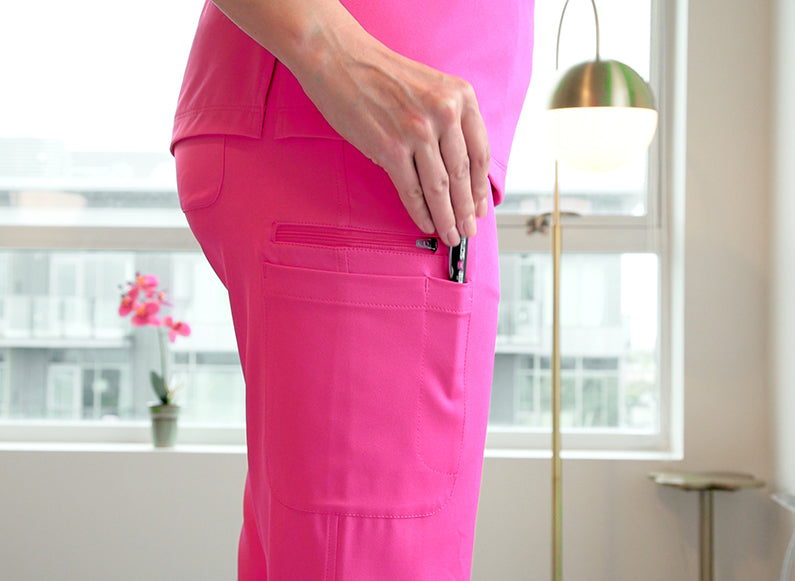An interview & nurse's guide on LGBTQIA inclusivity and creating a supportive work environment
As told to Maria Ortiz, RN. Written by Katie Taibl, RN.
Katie, the author, is a Pediatrics RN. They are being interviewed by their partner, Maria, who is a Psychiatric RN. They both work with LGBT+ patients frequently in these healthcare settings. Maria considers herself a “an old-school millenial gay,” whereas Katie considers herself a “queer advocate.” Both have experienced the ups and downs of working while gay in the healthcare industry for nearly a decade. The terms “gay,” “queer,” “LGBTQIA,” and “LGBT+” are terms used interchangeably.
Why is it important to have LGBTQIA healthcare professionals?
It’s important to have diversity in the workplace. Queer coworkers often posses an uncanny ability to make others feel accepted. This is derived from personal experience, which fosters a unique empathy and insight, overall enhancing care.
What does it mean to be LGBTQIA or queer?
The term “queer” is a highly inclusive LGBTQIA term. It lets folks of the LGBTQIA community shed constrictive heteronormative rules. This allows for essential flexibility in both identity and sexuality, which is important in the acceptance of your gay best friend or colleague.
For reference, LGBTQIA stands for Lesbian, Gay, Bisexual, Queer (questioning), Intersex, Asexual (agender).
What is your experience working in the medical field as a queer nurse?
It adds stress. I have experienced nurses speaking poorly of nonbinary, trans, and queer patients, in very invalidating terms. Sometimes it affected my focus while on the job.
Ultimately, it inspires me to advocate for other LGBT+ healthcare professionals, and especially for my patients. I have made it a point to be a visible LGBTQIA health care provider, especially for the pediatric patients I work with.
As a pediatric nurse, what have your experiences with LGBT+ kids taught you about inclusivity?
Parental affirmation of a child’s gender and respect for their identity is paramount. This starts with pronouns! If you accidentally misgender, don’t make it a big deal.
TIP 1: Acknowledge it, apologize and/or correct, then move on.
Queer kids are under a lot of stress. They are often asked to “come out” daily, which is more challenging with an unaccepting parent or caregiver. Many are in the hospital for suicide.
TIP 2: Be respectful of pronouns and gender identity.
Don’t use a child’s (or any person’s) deadname. Deadnaming is referring to a transgender or non-binary person by a name they used prior to transitioning. This could be their birth name, which may show up on the medical record. Though it may be accidental, it is often an intentional attempt to deny, mock or invalidate a person's gender identity. Either way, it is harmful.
TIP 3: Ask what they prefer to be called, and call them by their chosen name. It’s okay if it is different from what is listed in the medical chart.
How do you make (pediatric) patients feel comfortable and show your support?
One easy way I show my support is by wearing my pronouns pin and gay pride flag pin on my badge. This is a great way to make kids feel comfortable, and it can even start positive conversations!
I connected with a pediatric psych patient this way, and their mom. It was rewarding to be a physical representation of acceptance for this patient and their family.
Having queer nurses adds a level of diversity that is helpful for hospitals, especially for LGBT+ pediatrics patients.
What could help create a more inclusive and supportive work environment?
Orientations in hospitals depicting outright acceptance and advocacy for LGBTQ+ staff would make a significant impact for both patients and staff.
Visibility is really crucial in feeling comfortable within a workplace. When I was orienting at Children’s Hospital Los Angeles (CHLA), I was blown away by the inclusion of the gay pride parade photos from the LGBTQIA group at the hospital. I had never seen such nonchalance when it came to talking about gay healthcare providers, let alone acknowledging that they exist! It made me feel seen, supported, and included–and not in a way where I had to be the one to educate.
Include your pronouns in your work email signature. This is a simple yet formidable task for many professionals–I once deliberated if I should include pronouns in my email signature, and am glad I did!
Wear a pronouns pin. This is not restricted to queer providers–all providers can wear a pronouns pin, and it is an easy way to embrace inclusivity.
Are there some things you would love nurses to educate themselves on?
-
Gender identity and affirmation.
-
Pronouns.
-
The importance of creating a culture of inclusivity and openness.
Nurses and healthcare professionals who educate themselves on these topics, or any they are confused about, help create a culture of inclusivity.
Helpful resources include: hrc.org/resources and glaad.org.
Do you have advice for nurses going forward?
Treat gay, nonbinary, trans, and other LGBTQIA folks as you would want to be treated.
A good rule of thumb: If you wouldn’t ask a straight person, or think that about a straight person, then hesitate. It’s okay to question yourself.
We can all learn best together through respect, acceptance and allowance of visibility for LGBTQIA providers. We deserve access to a healthy working environment just as much as anyone else.
About the Author:
Hi, I’m Katie, a pediatric (travel) nurse who is also queer and nonbinary (pronouns: she/they). Check out my website altnursesstation.org (coming soon!) for more insight on queer healthcare and pediatric nursing. I nurse to live, and live to write. Email me to write for you (for pay): kmtaibl@gmail.com.





